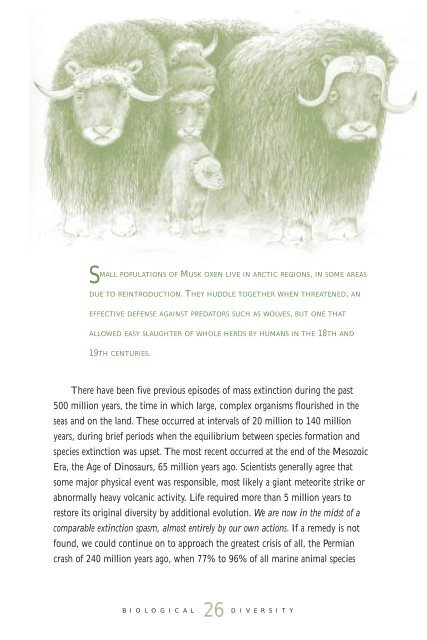Download Biological Diversity - New York State Museum
Download Biological Diversity - New York State Museum
Download Biological Diversity - New York State Museum
Create successful ePaper yourself
Turn your PDF publications into a flip-book with our unique Google optimized e-Paper software.
S<br />
MALL POPULATIONS OF MUSK OXEN LIVE IN ARCTIC REGIONS, IN SOME AREAS<br />
DUE TO REINTRODUCTION. THEY HUDDLE TOGETHER WHEN THREATENED, AN<br />
EFFECTIVE DEFENSE AGAINST PREDATORS SUCH AS WOLVES, BUT ONE THAT<br />
ALLOWED EASY SLAUGHTER OF WHOLE HERDS BY HUMANS IN THE 18TH AND<br />
19TH CENTURIES.<br />
There have been five previous episodes of mass extinction during the past<br />
500 million years, the time in which large, complex organisms flourished in the<br />
seas and on the land. These occurred at intervals of 20 million to 140 million<br />
years, during brief periods when the equilibrium between species formation and<br />
species extinction was upset. The most recent occurred at the end of the Mesozoic<br />
Era, the Age of Dinosaurs, 65 million years ago. Scientists generally agree that<br />
some major physical event was responsible, most likely a giant meteorite strike or<br />
abnormally heavy volcanic activity. Life required more than 5 million years to<br />
restore its original diversity by additional evolution. We are now in the midst of a<br />
comparable extinction spasm, almost entirely by our own actions. If a remedy is not<br />
found, we could continue on to approach the greatest crisis of all, the Permian<br />
crash of 240 million years ago, when 77% to 96% of all marine animal species<br />
B i o l o g i c a l<br />
26 D i v e r s i t y
















